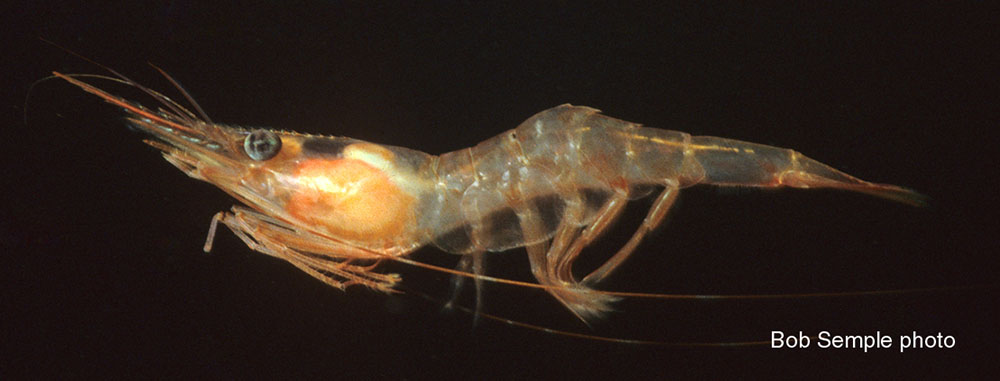Northern Shrimp
Latin Name
Pandalus borealis
Group Name
Invertebrates
Habitat
Northern shrimp have a wide range throughout the northern Atlantic and Pacific oceans, thriving in colder water temperatures between 2 to 6 degrees C. They are found mainly on soft and muddy bottoms. In the Atlantic Ocean, they occur from the Davis Strait south to the Gulf of Maine; in the eastern Pacific, they range from the Aleutian Islands to Oregon and in the west, from Siberia down to Japan. In Canada, the main fisheries are off the east coast of Nova Scotia, in the Gulf of St. Lawrence, and in Davis Strait and off the coasts of Labrador and northeastern Newfoundland.
Species Description
Northern shrimp are crustaceans with a hard exoskeleton. Their colour ranges from a light to a reddish-pink. They have a muscular body with four feeding legs and six walking legs, and a tail with attached pleopods (fins) that enables them to swim and escape danger quickly. Northern shrimp can grow to a length of about 15 centimetres, though they average about half this, and they are known to live for more than eight years in some areas.
Shrimp Assessment and Research
Pandalus borealis, (click on images for larger size), is the target of one of the largest fisheries in the world, currently worth about half a billion dollars. BIO science staff conduct annual assessments of the eastern Scotian Shelf stock and provide advice to DFO fisheries managers and the fishing industry on current stock health, future prospects and Total Allowable Catches (TACs). The assessment and advice are reviewed annually by the Regional Advisory Process and documented by the Canadian Science Advisory Secretariat as Research Documents and Science Advisory Reports.
In addition to the traditional "stock as bank account" approach, where the fish is a unit (dollar), and abundance (principal), recruitment (deposits), growth (interest), fishing and natural mortality (withdrawals) are determined by surveys and mathematical modelling, shrimp assessments attempt to take a more holistic view, in accord with the "Ecosystem Approach to Fisheries". In addition, harvesting strategies have always been conservative or "precautionary". As a result, the eastern Scotian Shelf stock has grown or remained at high levels throughout the history of the fishery. To further this approach BIO scientists and Canadian shrimp biologists developed the "traffic light" method (left), in which a suit of abundance, production, fishing impact and ecosystem indicators are considered in determining stock health and formulating management advice.
Understanding the biological mechanisms behind key environmental and ecosystem indicators of stock health, such as water temperatures and the abundance of predators, is a key part of developing and improving ecosystem-based stock assessments. To further this understanding, BIO scientists conduct research on the possible role of P. borealis as an indicator species of ecosystem and climate change, including the influence of top-down (e.g. predators) and bottom-up (e.g. phytoplankton abundance) processes on shrimp abundance. The species sits squarely in the middle of the North Atlantic Ocean's food web, between the small organisms that it eats, including the phytoplankton and zooplankton that form the base of the food web, and the top predators that eat it, like cod and other commercially important finfish. As a result, it is the marine equivalent of the canary in the mineshaft, sensitive to various types of changes in the ecosystem.
When groundfish stocks collapsed in the early 1990s shrimp populations exploded, partly due to release from predation pressure. Moreover, environmental conditions were also favourable for shrimp, in particular, water temperatures were colder. The reason behind North Atlantic shrimp populations' sensitivity to water temperature was discovered in an international study led by BIO scientists. They found that throughout the north Atlantic shrimp eggs hatch on average within days of the annual spring phytoplankton "bloom", when food is most abundant.
This is remarkable for two reasons:
- the summer-to-spring egg development period varies from 6-10 months, depending on bottom water temperatures (above), and
- the timing of the bloom varies throughout the ocean, depending on various factors such as latitudinal changes in solar radiation (right - day of year for spawning (blue), hatching (pink) and phytoplankton bloom (green); and below - timing of the spring bloom in the North Atlantic, red is later, green is earlier).
If the shrimp eggs are to hatch within days of the bloom everywhere in their range, their parents must mate at the correct time the previous year, taking into account local differences in egg development and phytoplankton bloom times. They have done this by adapting their life cycle to local conditions over evolutionary time periods, so that the hatch coincides with the bloom on average.
Since temperatures and bloom times are not always average, the relationship between egg hatch and bloom times developed over millenia may range out of phase, either decreasing or improving the larvae's chances of survival. As conditions change due to short term (inter-annual) variability in bloom times and bottom temperatures, or longer-term trends in these variables caused by global warming, the shrimp stocks will respond accordingly. Such a response, if interpreted correctly, could be an early warning of fundamental changes in the marine ecosystem requiring immediate corrective action not only to shrimp harvest strategies.
- Date modified:






